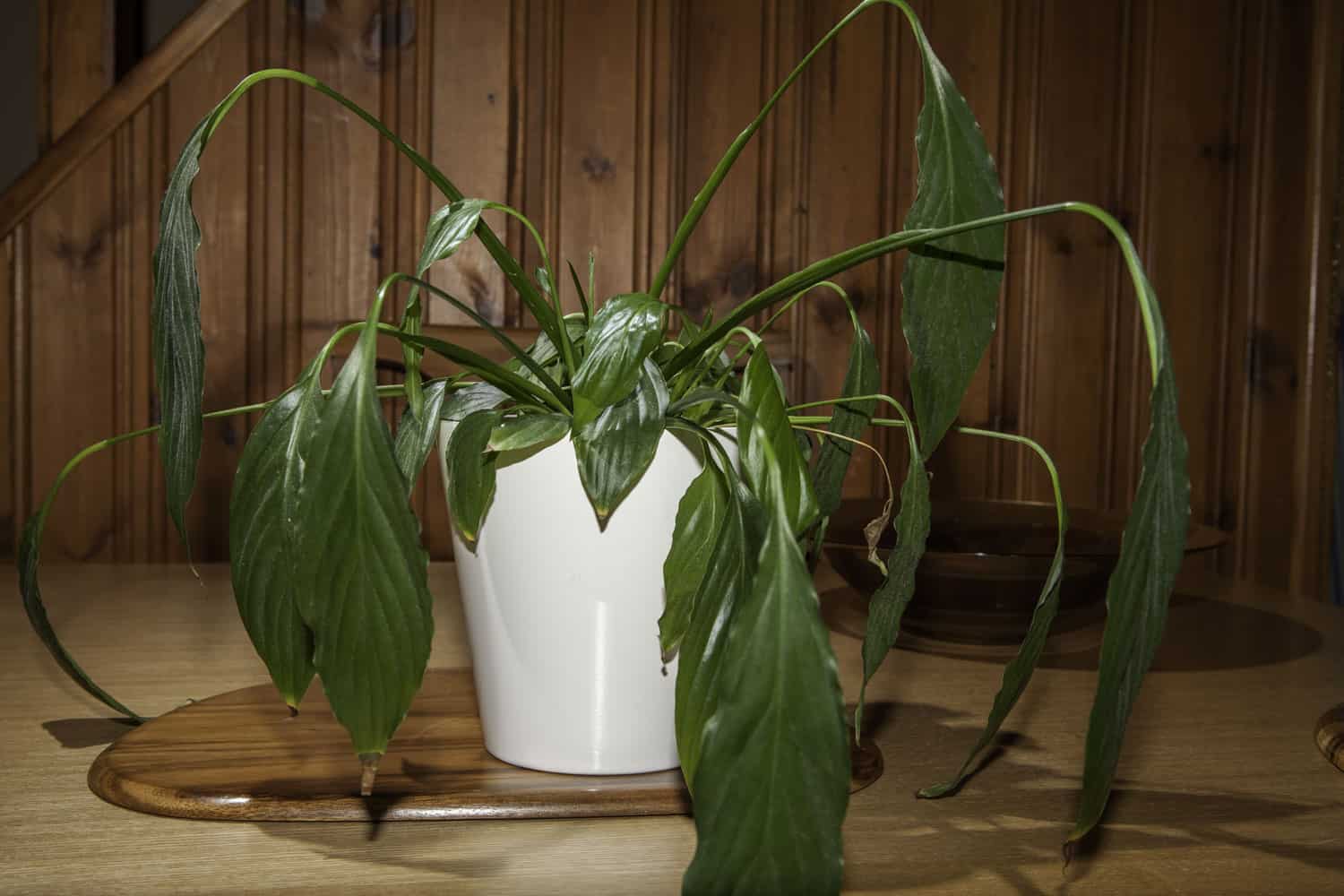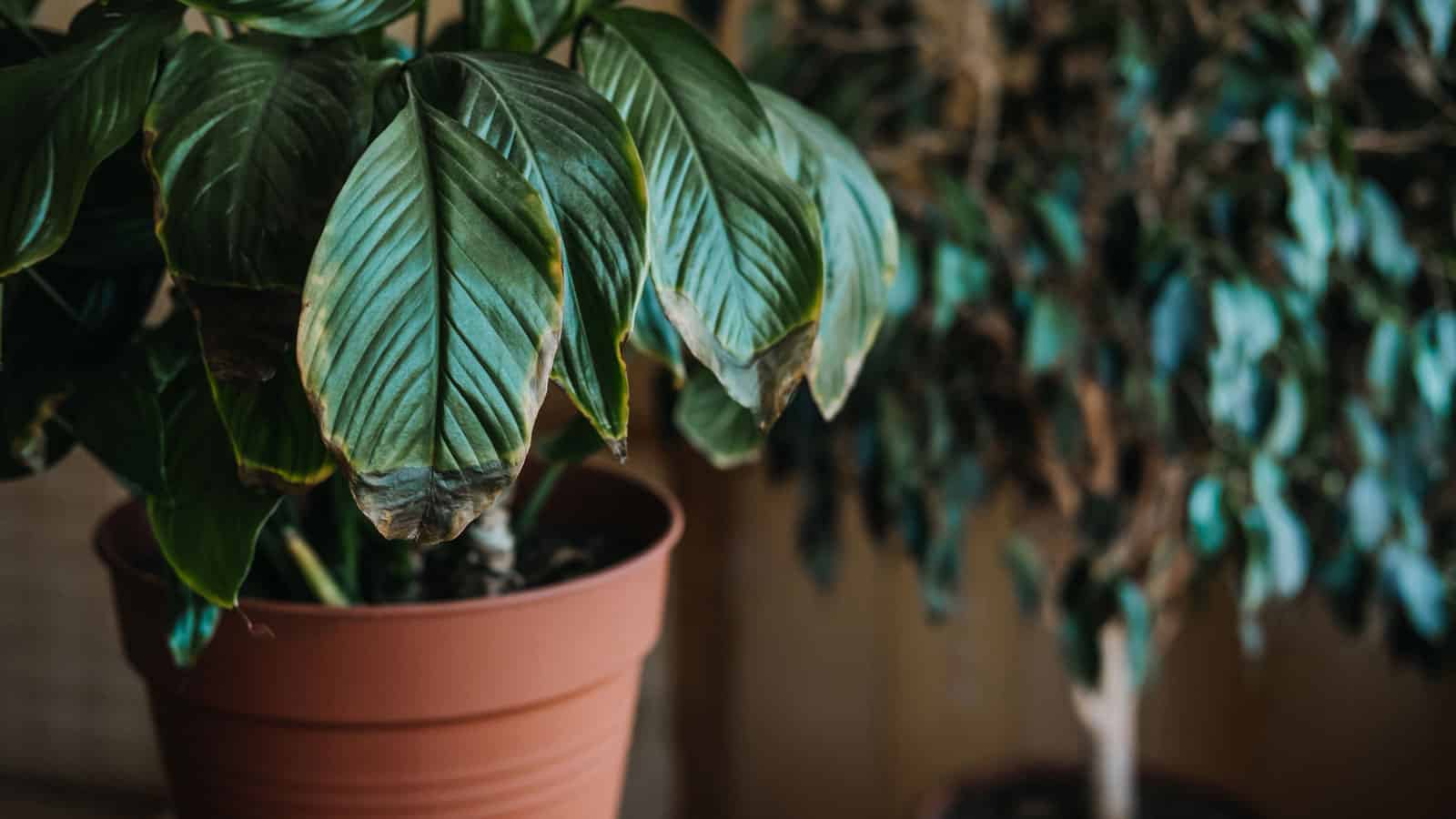Are you wondering why your peace lily seems to be drooping or wilting? You're not alone.
Taking care of a peace lily requires paying attention to some key factors such as its need for sufficient water, proper lighting, and suitable soil.

Peace lilies are also sensitive to environmental changes and can be affected by pests.
Below we will help you understand what's going on with your peace lily when you see signs of drooping and how to fix it.
Why is My Peace Lily Drooping?
If you notice your peace lily drooping, there are several common issues that can cause this problem.
Improper Watering
One primary reason for a drooping peace lily is improper watering. These plants prefer consistently moist soil but not overly wet.
If you're overwatering your peace lily, the roots may suffer from root rot, causing the plant to wilt.
On the other hand, underwatering can also lead to drooping. If the soil is too dry, the leaves will start to wilt.
To avoid this issue, check the moisture of the soil regularly and only water your plant when the top inch of soil feels dry.
Inadequate Lighting
Another possibility for a drooping peace lily is inadequate lighting. Peace lilies thrive in bright, indirect sunlight.
If your plant is placed in a dark corner or is receiving too much direct sunlight, it may begin to droop.
Temperature and Humidity
Temperature and humidity also play a role in the health of a peace lily. These plants enjoy a consistent indoor temperature between 68°F and 85°F.
If your home is too cold or experiences drastic temperature fluctuations, your peace lily may react by drooping.
Moreover, peace lilies prefer high humidity levels, which can be hard to maintain indoors.
You can increase humidity around your plant by using a pebble tray filled with water or by using a humidifier in the room.
Fertilizers
Over-fertilizing can lead to a buildup of salts in the soil, causing the plant to droop.
It's essential to use an appropriate balance of nutrients and follow recommended application rates on the fertilizer package.
Excessive Sunlight
Peace lilies thrive in bright, indirect sunlight, but they can suffer if exposed to direct sun for extended periods.
When your peace lily receives too much sunlight, it may result in the leaves becoming scorched, turning yellow or brown, and eventually drooping.
A spot near a window with filtered light or a well-lit room with natural light is a perfect location.
Inadequate Sunlight
Peace lilies require sufficient light to support their growth, and when not receiving enough, their leaves may appear droopy and dark green.
Moreover, insufficient light can hinder the production of their beautiful white blooms.
Ideally, you should place your peace lily within 5-8 feet of a bright, naturally lit window.
Pests and Diseases
Your peace lily might be drooping due to pests and diseases that can harm the plant.
One of the most common pests affecting peace lilies is the scale insect. These small insects attach to the plant and feed on its sap, causing leaves to wilt and turn yellow.
To check for scale insects, look for small, brown, oval-shaped pests on leaves and stems.
Another common pest is the spider mite. These tiny creatures can cause stippling and yellowing on the leaves, which may lead to drooping.
You can spot spider mites on the undersides of leaves as tiny, fast-moving dots.
Reviving a Drooping Peace Lily
You can use the following steps to revive your drooping peace lily:
- Remove the plant from its pot and gently remove any excess soil around the roots.
- Trim off any damaged or brown roots, and prune any yellow or wilted leaves.
- Soak the root ball in room-temperature water for 15 to 30 minutes, allowing the roots to take up needed moisture.
- Choose a well-draining pot and fill it with fresh, moist potting soil.
- Place your Peace Lily back into the pot, making sure the roots are well covered with soil.
- Water the plant lightly, and ensure it's placed in a location with indirect sunlight.
What Causes a Peace Lily to Droop After Repotting?
Repotting a peace lily might cause it to droop temporarily due to stress or shock from the process.

Don't worry, your plant will usually recover once it gets used to its new environment.
There are a few possible reasons behind drooping after repotting, and here's what you can do to help your peace lily bounce back.
Inadequate Watering
After repotting, your peace lily might need some time to adjust to new growing conditions. Make sure to keep the soil consistently moist but not soggy.
Damaged Roots
During the repotting process, it's possible that some of your peace lily's delicate roots were damaged.
To help the plant recover, avoid overwatering and ensure the pot has proper drainage to prevent root rot.
In a few weeks, new roots should grow and your plant will regain its energy.
Pot Size
If your peace lily is drooping after being transferred to a much larger pot, it could be due to the excess soil retaining more moisture than needed, leading to overwatering.
To remedy this, try repotting your peace lily in a pot slightly larger than the previous one, giving the roots room to grow without excess water.
When repotting, the rule of thumb is that the new pot should be at least 2 inches larger in diameter than the original pot.
Adaptation
Peace lilies can be sensitive to change. After repotting, it might take some time for your plant to adapt to its new environment.
Other factors also come into play such as differences in temperature, humidity, or light conditions.
Ensure to provide your peace lily with bright, indirect light and maintain a comfortable humidity level of around 40-50%.
Saving Your Peace Lily from Drooping
As you care for your peace lily, keep in mind that drooping can occur for various reasons.
By understanding these common issues and being attentive to your peace lily's needs, you can help ensure a healthy, resilient plant.
Remember, a little care goes a long way in maintaining a vibrant, thriving peace lily.
Happy gardening!
